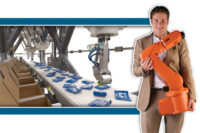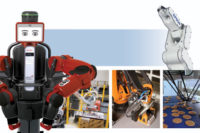Cover Story: Robotics in Packaging
Robots in packaging: Expanded flexibility, greater capability
Robots have increased their role in packaging and will increase it further in the years to come. Here’s why.








Packagers in the food and beverage sector face increasing demands for greater flexibility and efficiency. Meeting these seemingly contradictory demands can be a tall order; fortunately, developments in robotic automation are making that task a whole lot easier.
Take vision for example. Robots have become a familiar sight in palletizing operations but in recent years they have been moving upstream into the heart of the packaging operation. The close integration of robots with modern vision technology is facilitating that trend.
Though of undeniable usefulness, vision systems used to be difficult to install, program and maintain, and were very expensive, as well. They were thus suitable, for the most part, only for very large manufacturing operations. No longer.
Today, advances in computing power along with developments in imaging have enabled vision suppliers to pack more capabilities into systems and components that often are both smaller and cheaper.
“Recent vision developments have expanded from traditional grayscale technology to include color recognition and analysis,” says Dick Motley, senior account manager, Fanuc Robotics (fanucrobotics.com) packaging distribution network, “as well as ‘hyper spectral’ imaging that allows robots to analyze and react to product characteristics that can’t be seen with the human eye.”
As a result of developments like these, Motley says, “robots with integral machine vision can see and adapt to changing production requirements while providing in-process inspection to help ensure product quality and traceability.” The flexibility to adapt can be a critical factor in today’s packaging environment where new products and new packaging debut at a faster rate than ever before. Similarly, today’s vision-assisted robotic systems, particularly those with increasingly affordable three-dimensional (3D) vision technology, help manufacturers and packagers to economically address heightened requirements for flexibility, tracking and quality.
Among other things, 3D vision opens the door to bin picking, or the ability of a robot to select randomly oriented items. This enables robots to identify and pick not only misaligned items but unusual items as well – things like misshapen packages, dented cans or underfilled bottles.
For many years it was considered a distant, perhaps never to be attained goal – the “holy grail” as Adil Shafi, president of Advenovation Inc. (advenovation.com) puts it. As vision system integrators, Shafi’s firm, which specializes in software for vision-assisted robotics, has helped to create systems for numerous companies, among them a growing number of bin picking systems, boosting quality and typically saving time as well.
In addition to improved, more cost effective cameras, “Smaller, more effective vision sensors that can deliver data directly to the robot’s controller will become more common,” says Jim Anderson, national product manager – vision and 2D code readers for sensor specialist Sick Inc. (sick.com). Anderson says this combination of vision-enabled precision and robotic flexibility is opening up new possibilities. For instance, he envisions baked goods packaging lines that could switch quickly “from baguettes to bagels to croissants with little downtime if vision-aided robotics was used.”
Enhanced computing power
Clearly vision has become a powerful force in extending robotic capabilities, but what about the robots themselves? They have been impacted by a powerful force that is affecting all aspects of automation: heightened computing power. “Increases in computing power and speed are allowing robot suppliers to develop lower-cost, higher-performance robots, along with user-friendly software,” continues Anderson. He adds that “advances in communications now allow robots to be integrated seamlessly with plant networks and other surrounding machine controls.”
The importance of that last point – easier integration with other control systems – can’t be overstated. As Per Vegard Nerseth, the head of ABB Robotics (abb.com ) worldwide has stated, “Ease of deployment and programming is also a large technical challenge that the [robot] industry is grappling with. As an increasing number of companies find that robots are within their affordability range, it is clear that one of the final barriers to adoption is the perceived complexity of programming and designing robotic systems.”
Easier integration is helping to crack that barrier, bringing down programming time and cost. Maintenance, too, is enhanced. Why? Because all needed maintenance information can be easily accessed from one central location. And, since there is less programming overall, there are fewer potential points of failure.
A recent example of this growing trend is the MLX200 from the Motoman Robotics Division of Yaskawa America Inc. (yaskawa.com). MLX200 is the newest control platform for Motoman, and it is integrated with the widely used Rockwell Logix control system.
“MLX200 brings the unified controls architecture concept to reality,” claims Roger Christian, vice president of marketing and business development for Motoman. “If conveyors, sealers, wrappers and most packaging equipment are controlled through a PLC ladder and Rockwell platforms then robots should not be any different.” With this unified approach, he notes, “robots are maintenance staff-friendly as troubleshooting of the entire system happens in one place, in one language. Multiple programming languages are no longer required.”
A unified controls architecture also yields benefits in terms of simulation. What’s the big deal you might say; we have long been able to simulate robot operations. True, but with a unified controls architecture the users can easily and accurately simulate the robot within the larger system, such as the packaging line, within which it will be operating. The potential benefits in terms of time and cost of initial deployment and product changeover are dramatic.
The increasing sophistication and ease of use of simulation software, particularly when deployed in a unified controls environment, is something that robot companies have been quick to exploit. Fanuc, for example, offers a software package known as PickTOOL. This gives users the ability to change system parameters like conveyor speeds, indexing rates, grip and drop delays, payloads, approach vectors and load balancing ratios – in short, the entire spectrum of robot operation. Similarly, their Roboguide family of simulation software packages provides the ability to create, program and simulate a robotic workcell in 3-D, without the need or expense of physical prototypes.
Palletizing
The robot invasion of the packaging industry began many years go with palletizing /depalletizing. Long before the applications described above, robots were at work – albeit a small number of them at first – loading and unloading pallets. Small wonder, as this heavy and repetitive work is tough on humans, leading to excessive worker turnover and high rates of expensive injuries. Conventional palletizing machines are typically reliable and efficient, but inherently inflexible. Robots, even before the advent of today’s more powerful, intuitive and integrated controls, could be reprogrammed to accommodate product changes more quickly than conventional machines.
Just as the need for packaging flexibility has steadily increased throughout our new century, the capability of palletizing/depalletizing robots has increased as well. For an example of their new capabilities one need look no further than last year’s Automate trade show in Chicago.
There, in the ABB Robotics palletizing demo, several ABB robots were palletizing and depalletizing several configurations of corrugated cases with the robot cell under the control of ABB’s PalletPack 460 software. Palletizing system operation could be changed via the configuration wizard on the robot’s teach pendant, eliminating the need for traditional robot programming. The software also powered a pendant-based HMI for cell operation, and an integral ABB PLC controlled the flow of product on the infeed conveyors and pallet conveyors as well as gripper operation, which was prefigured in the software. In addition, simulation models could be downloaded to the robot controller.
The other robot companies have their stories to tell concerning palletizing/depalletizing capabilities as well. It’s no wonder, then, that industry experts predict strong sales growth in this area in the years ahead.
The spider
Lastly, we look at the physical configuration of the robot itself. In fact it hasn’t changed much. Sure, there have been undeniable improvements in terms of more efficient gear boxes, higher speeds, greater strength and improved reliability. It’s an improved package, but the look of that package hasn’t changed much – until recently.
The new kid on the block is the Delta robot, a strangely shaped multi-arm contraption that some people have likened to a spider. A Delta is a parallel-link robot in which its major mechanical axes act on the robot faceplate in parallel rather than in series. This allows for speeds that are difficult or impossible to attain with a conventional serial-link design. In fact, top speeds of 10 meters per second are typical for most Delta robots. In addition to high speed performance, these parallel-link robots provide improved repeatability at the tool tip.
Though developed in the 1980s, large scale deployment was hindered by a patent dispute. Only in recent years, after the resolution of that dispute, have Delta robots begun to show up in increasing numbers. Though typically smaller and lower in payload capacity than conventional robots, they are ideal for many high speed pick and place applications. Expect to see more of them on packaging lines in the future. The same can be said for robots in general.
Looking for a reprint of this article?
From high-res PDFs to custom plaques, order your copy today!









